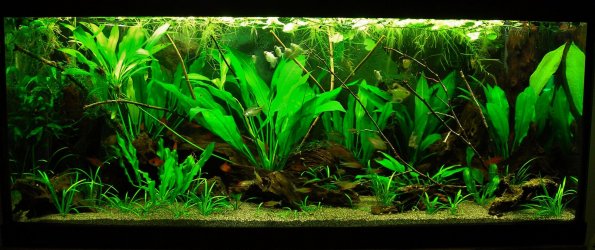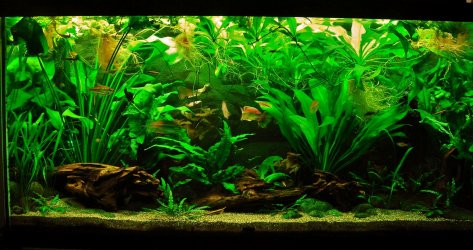Well, my previous (and only) experience with aquaria (you can see the details below) used plain sand, and fertilizer tablets (Tetra Crypto), same lights mentioned above, and no CO2. Pretty bad results, but surely brackish water doesn't help... So I promised to myself to use a growth substrate in my next experience (now).
I would suggest the issue here was too much light. T5 HO tubes are very intense lighting, and without CO2 and regular (daily) fertilizing, this would not likely work. It could, but it takes a lot of effort; floating plants can help, and less duration. Brackish water could also factor in, depending upon plant species. Salt literally dehydrates plant leaves, same as leaving them in the air, and while some plants can manage, others cannot. We can leave this, but just thought I'd mention the likely issues.
My plan is to use Dennerle Crystal Quarz gravel Diamond black - size 1-2 mm, reportedly safe for bottom dwellers (I'm not planning any, but let's play safe) - as a topping, and a substrate for better plant growth. I'll happily skip on the latter, if you say I can live with just tablets!!
First, on mixing substrates. This can work, but make sure you plant all the substrate-rooted plants in the first "enriched" layer before adding the top fine gravel layer, otherwise you will mix them. They may mix naturally with time, depending upon the substances themselves. Water is (or should be) continually moving through a healthy substrate. The water in the substrate is warmed by the bacterial decomposition, and it rises back up into the aquarium while the cooler water will percolate down. This can often mix substrate materials and move them about, more than one might think.
As for the benefit of the enriched bottom layer, this depends upon the substance and the plant species. If you want a carpet layer (say dwarf hairgrass or clover-types) covering the substrate, then an enriched first layer might benefit. But you can always add liquid nutrients which will, because of the water flow through the substrate I mentioned above, get down to the plant roots. But many plants will do just as well without this. You are intending CO2 and you have intense lighting, so nutrient supplementation will be essential in some form. I've never gone down this road, as I have no need to, since I maintain fish with plants being secondary and provided they thrive I'm happy. I stay with those that do.
I'll add a photo of my present 70g and 90g tanks just so you can compare; these are natural or low-tech systems, no CO2, some liquid fertilization, substrate tabs next to the larger swords and lotus, and moderate lighting which is two 48-inch T8 tubes, one 6500K and one 5000K over each tank. The plants are growing like weeds.





